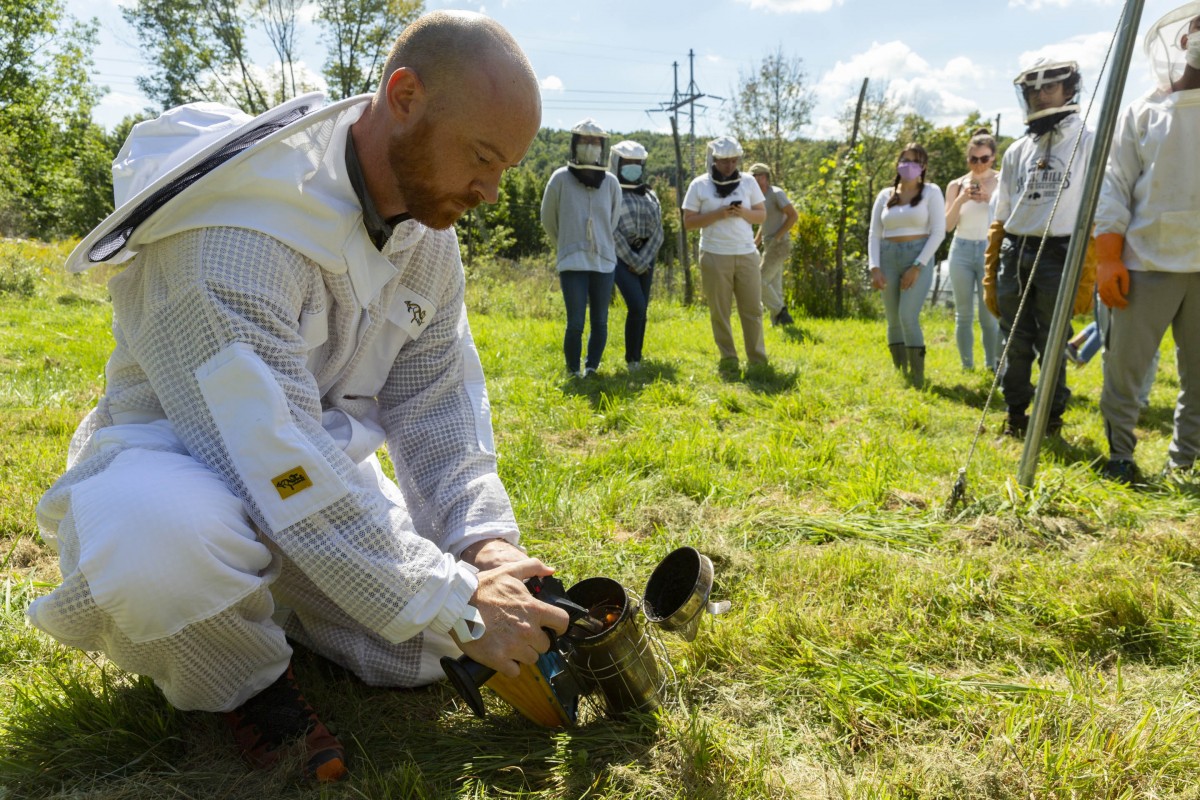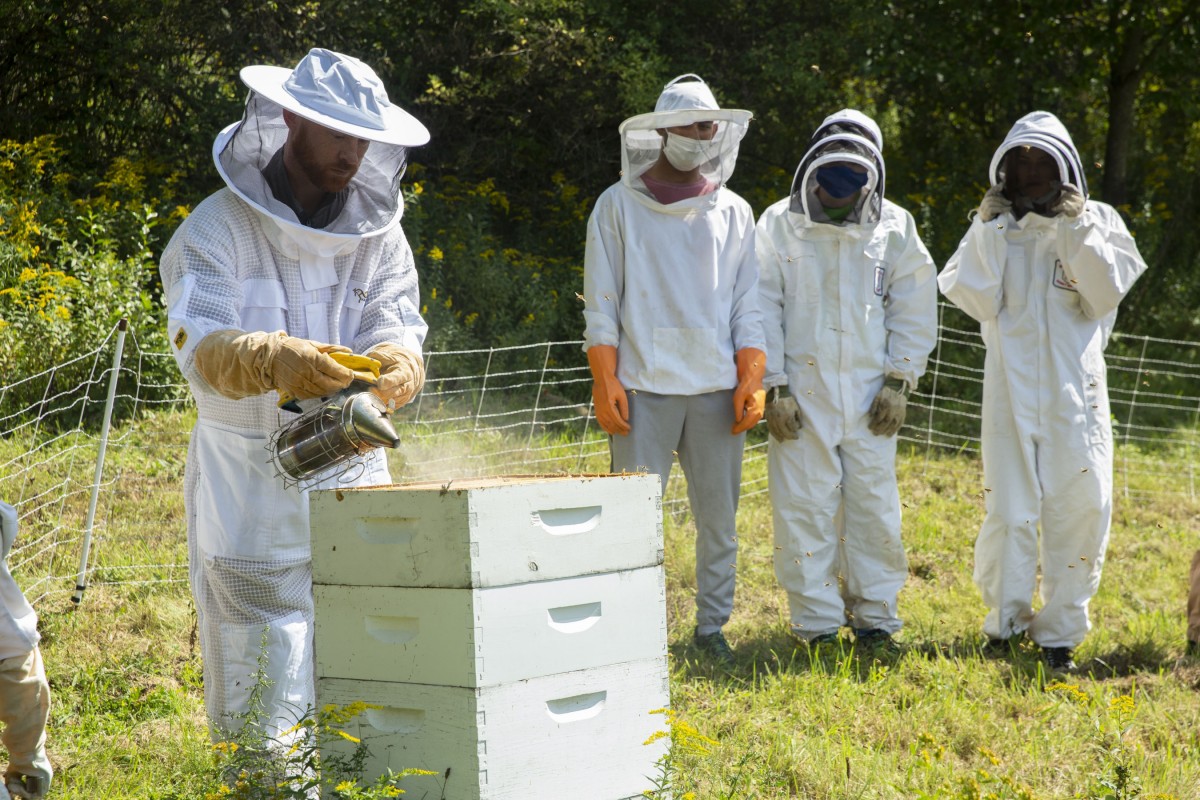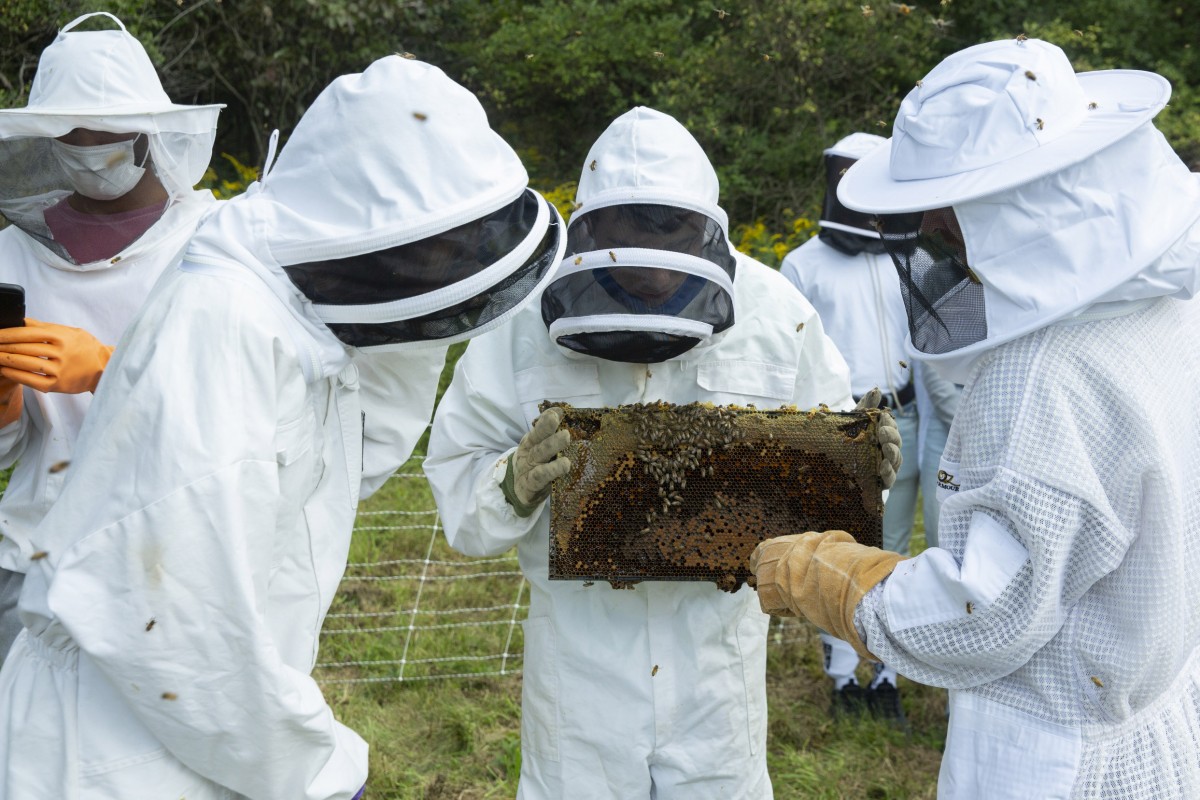The buzz: Campus initiatives put the bee in Binghamton

There is an energy that comes with having 50,000 stinging insects whirling around your head as you carefully dismantle their home, oozing with sweetness and — occasionally — pain.
That’s what those unwieldy beekeeper suits are for, as Environmental Studies Instructor George Meindl and members of the Binghamton University Bee Club know well. Honeybees have their own residence hall of sorts at Binghamton University Acres, a small, sustainable farm off Bunn Hill Road.
Members of the beekeeping club do more than learn about the importance of pollinators; they also engage in hands-on activities, ranging from hive maintenance and honey collection to a honey face-mask event, explained president Erin Kelly, a senior majoring in biological sciences and environmental sciences. The apiary’s honey is sold to provide for its upkeep.
“It’s a way of showing people why it’s important in our day-to-day lives to ensure that these pollinators remain healthy. That way, we can continue to have these amazing resources that they provide,” Kelly said of the club’s outreach events.
The apiary is an education tool that teaches students about honeybee biology and their importance in worldwide food production, from agriculturally important crops such as almonds to honey. By taking apart colonies, students learn about honeybee biology, as well as the steps involved in extracting honey.
Binghamton Fund donors who gave to Harpur College of Arts and Sciences or campus enhancement are fostering these initiatives.
This fall, club members performed a hive inspection and mite check on the apiary, aided by Meindl and other professors in billowing white gear. Mites are one of several problems devastating honeybee populations, along with diseases, poor nutrition and pesticides used in agriculture. Unfortunately, the handful of bees that students tested proved positive for Varroa mites, so members followed up with a treatment to keep the bees healthy, Kelly said.
The Binghamton University community is committed to safeguarding healthy pollinator populations, and not just honeybees. Binghamton was recently designated as a Bee Campus USA Affiliate, one of only five campuses in New York state to receive the designation.
To qualify as a Bee Campus USA, campuses must foster pollinator habitat through increasing the abundance of native plants, providing nesting sites, reducing the use of pesticides and offering courses, service-learning projects or continuing education communities to incorporate pollinator conservation.
While they play an important role in commercial agriculture, honeybees aren’t native to North America and were brought to the continent by European colonists, Meindl said. However, North America has many native bee species that are equally effective as pollinators, although urbanization has taken a toll on their populations. But even urban landscapes can be shaped to maintain adequate habitat for pollinating insects.
“We need to manage built environments in ways that also promote abundance and diversity of plants and animals. With pollinators, it’s relatively straightforward how to do that right,” Meindl said. “We just have to provide them with vegetated areas that offer a diversity of floral resources and habitats where they can create nests.”
There are more than 20,000 species of bees worldwide and most are solitary, lacking the large colonies that are central to the honeybee life cycle. In these solitary species, individual female bees create their own nests and spend the rest of their lives collecting flower resources to provision their eggs. One mark in their favor: because they don’t make honey or have group resources to protect, many of these species don’t pack the strong sting of honeybees.
Supporting pollinators
“Pollinators provide arguably the most important ecosystem service. It’s estimated that approximately 90% of flowering plants require biotic pollination, so they need animals to visit their flowers in order for them to reproduce and to produce seeds,” Meindl explained. “Without seeds, we don’t have subsequent generations of plants and we don’t have the foundation of terrestrial ecosystems.”
Campus initiatives that foster native pollinators include “low-mow areas,” where the grass grows higher than the standard American lawn, speckled with dandelions, clover and other flowers. These spots increase biodiversity on campus, providing spaces free from pesticides and fertilizers where pollinators can find the resources they need. Mature low-mow areas also attract bird species and provide safe resting places during migration, said Nick Corcoran, a landscape architect with the Department of Physical Facilities.
“Low-mow areas also increase vegetation diversity, which in turn attracts different insects, which then attract different invertebrates, which then attract new insectivores. Over time that system continues on up the food chain, potentially attracting a large number of diverse species of wildlife,” he said.
There are other benefits, too: low-mow areas decrease fossil food consumption, increase drought tolerance and improve storm water filtration.
The campus also has a new pollinator garden located near the Harpur College monolith. It features native plants of various sizes, floral shapes and colors to promote a diversity of pollinating insects, from bees to butterflies. On the butterfly front, the space also includes a plant essential to monarch butterfly survival: milkweed.
One of the forces behind the initiative was junior Wren Evans, an environmental policy major who focused on the creation of the garden for an independent study project with Meindl. Evans is involved with the Bee Club and currently heads IDEAS for Binghamton, a campus sustainability club.
“Our main problem is that we don’t have a lot of biodiversity; pollinators would like to have large meadows, and we tend to replace that with lots of grass,” Evans explained. “In grass, clover and dandelions are good for bees, but there aren’t a lot of tall plants for monarchs and moths. In a garden like this, you want a lot of different colors and shapes, which increases the diversity.”
Corcoran assisted students with the garden’s physical design, although they didn’t need much help; their plans encompassed a wide variety of native plants, chosen so that at least one species was in flower during any point of the growing season. They varied the height as well, and made sure the selection drew as wide a variety of pollinators as possible, he said. He then helped get their plan approved by the Campus Appearance Task Force, and with ordering and delivering the plants to the site.
“The students were the real work horses on all of this,” he said.
The Campus Grounds Department — particularly Jonathan Reynolds and Rich Smith — also played an important role, removing existing overgrown planting material, importing new topsoil and mulch, and watering the plants when needed. They even trapped a few woodchucks that considered the new garden a tasty buffet.
Earlier this season, the bee balm around the new garden’s edges drew honeybees and bumblebees, along with butterflies and moths, Evans observed. Small white cabbage moths and monarchs are increasingly common visitors.
By collaborating with other clubs, Evans hopes to foster the pollinator garden as both an educational and social space. Future activities could include seed-saving and installing educational signs, benches and more.
“There were just ornamental grasses there before. It’s a much more useful space now,” Evans said.


